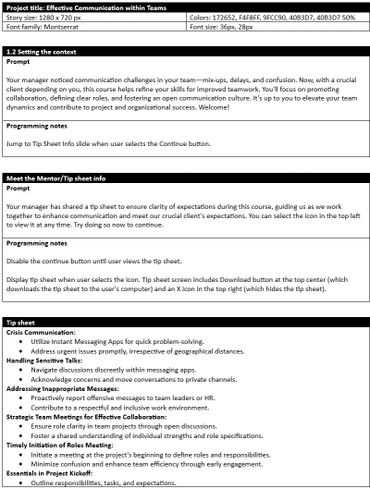Featured Project
Building Strong Teams: Mastering Effective Communication
This immersive scenario-based eLearning concept project was designed to help elevate team dynamics by promoting collaboration, defining clear roles, and fostering an open communication culture.

Overview
Tools Used
Responsibilities
The Audience
Articulate Storyline 360
Miro
Figma
Freepik
Google Suite
MS Powerpoint
The Audience
Responsibilities
The Audience
Employees in the company, including team members, managers, new hires, and cross-functional teams
Responsibilities
Responsibilities
Responsibilities
Instructional design
eLearning development
Action mapping
Storyboard
Visual design
Prototype creation

Problem
This concept project is for a fictional company facing significant challenges with effective communication within its teams. Despite having talented individuals and ambitious projects, the company struggles with miscommunication, unclear roles and responsibilities, and a lack of coordination among team members. This results in missed deadlines, duplicated efforts, and frustration among employees. As a result, the company's productivity and morale are declining, jeopardizing its ability to deliver high-quality products and services to clients.

Solution
By conducting a needs analysis, I confirmed that we could solve this issue with a scenario-based learning experience. The scenario-based eLearning approach provides practical, real-world scenarios that resonate with the audience, enabling them to apply their learning directly to their workplace situations and gain the necessary skills and knowledge to lead their teams effectively and overcome communication barriers.
Project Design and Development
1. Identify the Need
2. Create an Action Map
3. Write a Text-based Storyboard
4. Design Visual Mockups
5. Develop an Interactive Prototype
6. Develop the Final Product
Action Mapping

In this project, I acted as the Subject Matter Expert (SME), drawing on my experience from facilitating communication and collaboration among diverse groups of students and ensuring smooth operations. The action map included the measurable goal, and the specific actions needed to achieve it. This ensures the resulting project will include relevant, crucial activities for the learner to complete.
Text-based Storyboard



After creating the action map, I outlined the learning experience from beginning to end using a text-based storyboard. Google Docs was my tool of choice for its simplicity and cloud-based functionality, allowing me to save and organize my work efficiently. This process involved detailing every aspect of the slide, from title screens to interaction prompts and programming notes. Drawing insights from the action map, I crafted questions, actions, and consequences to weave into the scenario, aiming to reinforce desired behaviors through consistent yet varied storytelling. This storyboard served as the blueprint for the project's overall development, ensuring a cohesive and effective learning experience. At this stage, I would seek client approval on the storyboard to ensure alignment with their expectations and requirements.
Visual Mockups

I used Figma for creating visual mockups, which happened to be my favorite part of the process. It was exciting to witness the project starting to come to life through the visual representations, and I particularly enjoyed the creative element it brought to the table. To begin, I developed a mood board followed by a style guide to organize my inspiration and maintain consistency throughout the design.

Next, I created wireframes to determine the layout of various elements on the slides, ensuring a polished and professional visual presentation.

Finally, I crafted high-fidelity mockups, allowing me to visualize the project's aesthetics with clarity and detail.
Throughout this process, I learned the importance of making iterations and creating multiple versions tailored to the information presented on each slide.
Interactive Prototype

I developed an interactive prototype using Figma to gather feedback on the project's functionality before proceeding with full development. This prototype featured essential components including the title slide, introduction, mentor introduction, first question, and consequences for both correct and incorrect choices. It offered an initial preview of the project's visual and functional aspects, serving as a foundation for further refinement.
Final Product

After incorporating the feedback I received, I finalized the project design for an immersive and user-friendly experience. The programming features tasteful animations during transitions between elements such as text boxes and slides. I implemented variables and conditions to direct learners to the appropriate consequence based on their selections and added hover states to emphasize potential answer choices. Additionally, I designed unique animations and slightly varied styles for certain screens to enhance engagement.
Results & Takeaways
Throughout the design and development process, timing played a crucial role. Balancing animations with text prompts to maintain a steady pace for learners required careful consideration. While sound effects were minimal, they added a dramatic flair to the story, sparking ideas for future projects. Completing the text-based storyboard proved challenging, as I'm more of a visual learner. Next time, I intend to streamline the process by using a storyboard template with visuals. Despite the challenges, I gained a deeper appreciation for instructional design, which demands attention to detail, patience with technology, and a thoughtful approach. Developing this scenario-based learning experience was rewarding, particularly with positive feedback on its visual appeal and engaging interactions. Moving forward, I aim to enhance the learning experience by utilizing Vyond for improved animations and crafting more dynamic characters. Through these enhancements, I aspire to create a more immersive and impactful learning journey for users.
This website uses cookies.
We use cookies to analyze website traffic and optimize your website experience. By accepting our use of cookies, your data will be aggregated with all other user data.
